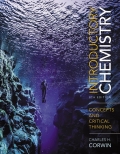
Concept explainers
Interpretation:
The mass of water produced when
Concept introduction:
Answer to Problem 65E
The mass of water produced when
Explanation of Solution
The reaction is given below.
The balanced equation for the reaction is given below.
In the reaction,
Therefore, the mole ratio is given below.
The mole ratio to obtain moles of
The molar mass of aluminum is
The molar mass of hydrogen is
The molar mass of oxygen is
Therefore, the molar mass of
The formula to calculate the moles of
The mass of
Substitute the molar mass and mass of
The formula to calculate the moles of
Substitute the value of moles of
In the reaction,
Therefore, the mole ratio is given below.
The mole ratio to obtain moles of
The molar mass of hydrogen is
The molar mass of oxygen is
The molar mass of sulfur is
Therefore, the molar mass of
The formula to calculate the moles of
The mass of
Substitute the molar mass and mass of
The formula to calculate the moles of
Substitute the value of moles of
Since,
The number of moles of
The molar mass of hydrogen is
The molar mass of oxygen is
Therefore, the molar mass of
The formula to calculate the mass of
The moles of
The molar mass of
Substitute the molar mass and moles of
Therefore, the mass of water produced when
The mass of water produced when
Want to see more full solutions like this?
Chapter 9 Solutions
EBK INTRODUCTORY CHEMISTRY
- Nitric acid is produced commercially by the Ostwald process, represented by the following equations: 4NH3(g)+5O24NO(g)+6H2O(g)2NO(g)+O2(g)2NO2(g)3NO2(g)+H2O(l)2HNO3(aq)+NO(g) What mass of NH3 must be used to produce 1.0 106 kg HNO3 by the Ostwald process? Assume 100% yield in each reaction, and assume that the NO produced in the third step is not recycled.arrow_forwardWhat is the molarity of a solution of sodium hydrogen sulfate that is prepared by dissolving 9.21 g NaHSO4 in enough water to form 2.00-L solution? What is the molarity of each ion in the solution?arrow_forwardYou are given a solid mixture of NaNO2 and NaCl and are asked to analyze it for the amount of NaNO2 present. To do so, you allow the mixture to react with sulfamic acid, HSO3NH2, in water according to the equation NaNO2(aq) + HSO3NH2(aq) NaHSO4(aq) + H2O() + N2(g) What is the weight percentage of NaNO2 in 1.232 g of the solid mixture if reaction with sulfa-mic acid produces 295 mL of dry N2 gas with a pressure of 713 mm Hg at 21.0 C?arrow_forward
- When an electric current is passed through an aqueous solution of NaCI, the valuable industrial chemicals H2(g), Cl2(g), and NaOH are produced. 2 NaCI(aq) + 2 H2O(l) H2(g) + Cl2(g) + 2 NaOH(aq) What mass of NaOH can be formed from 15.0 L of 0.35 M NaCI? What mass of chlorine is obtained?arrow_forward4.25 When octane is combusted with inadequate oxygen, carbon monoxide may form. If 100 g of octane is burned in 200 g of O2, are conditions conductive to forming carbon monoxide?arrow_forwardWrite a balanced equation for the reaction of hydroiodic acid, HI, with calcium hydroxide, Ca(OH)2. Then, write the balanced complete ionic equation and the net ionic equation for this neutralization reaction.arrow_forward
- 4.24 Ammonia gas can be prepared by the reaction CaO(s)+2NH4Cl(s)2NH3(g)+H2O(g)+CaCl2(s) If 112 g of CaO reacts with 224 g of NH4Cl, how many moles of reactants and products are there when the reaction is complete?arrow_forward4.19 How many metric tons of carbon are required to react with 7.83 metric tons of Fe2O3 according to the following reaction? 2Fe2O3+3C3CO2+4Fe How many metric tons of iron are produced?arrow_forwardSilicon is produced for the chemical and electronics industries by the following reactions. Give the balanced equation for each reaction. a. SiO2(s)+C(s)arefurnaceElectricSi(s)+CO(g) b. Liquid silicon tetrachloride is reacted with very pure solid magnesium, producing solid silicon and solid magnesium chloride. c. Na2SiF6(s) + Na(s) Si(s) + NaF(s)arrow_forward
 Chemistry & Chemical ReactivityChemistryISBN:9781337399074Author:John C. Kotz, Paul M. Treichel, John Townsend, David TreichelPublisher:Cengage Learning
Chemistry & Chemical ReactivityChemistryISBN:9781337399074Author:John C. Kotz, Paul M. Treichel, John Townsend, David TreichelPublisher:Cengage Learning Chemistry & Chemical ReactivityChemistryISBN:9781133949640Author:John C. Kotz, Paul M. Treichel, John Townsend, David TreichelPublisher:Cengage Learning
Chemistry & Chemical ReactivityChemistryISBN:9781133949640Author:John C. Kotz, Paul M. Treichel, John Townsend, David TreichelPublisher:Cengage Learning Chemistry: Principles and PracticeChemistryISBN:9780534420123Author:Daniel L. Reger, Scott R. Goode, David W. Ball, Edward MercerPublisher:Cengage Learning
Chemistry: Principles and PracticeChemistryISBN:9780534420123Author:Daniel L. Reger, Scott R. Goode, David W. Ball, Edward MercerPublisher:Cengage Learning Chemistry for Engineering StudentsChemistryISBN:9781337398909Author:Lawrence S. Brown, Tom HolmePublisher:Cengage Learning
Chemistry for Engineering StudentsChemistryISBN:9781337398909Author:Lawrence S. Brown, Tom HolmePublisher:Cengage Learning
 Chemistry: An Atoms First ApproachChemistryISBN:9781305079243Author:Steven S. Zumdahl, Susan A. ZumdahlPublisher:Cengage Learning
Chemistry: An Atoms First ApproachChemistryISBN:9781305079243Author:Steven S. Zumdahl, Susan A. ZumdahlPublisher:Cengage Learning





